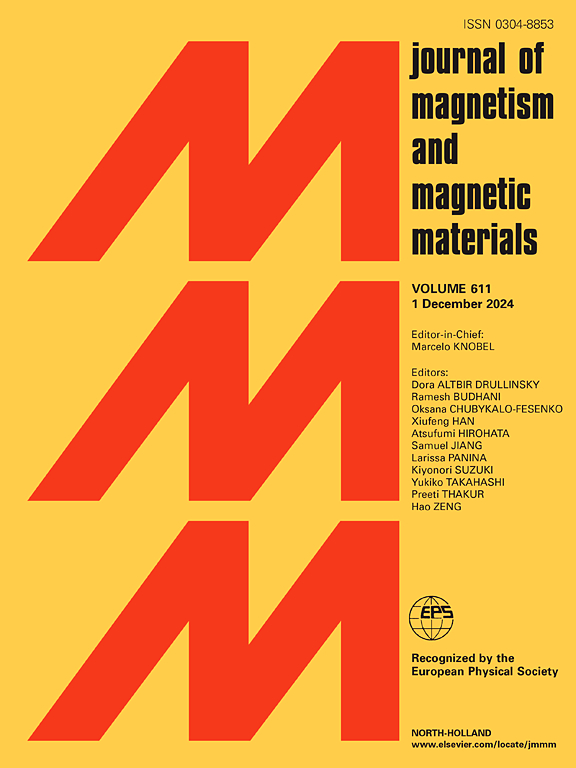Mechanism of hysteresis effect in levitation electromagnet under large gap fluctuation and its influence on dynamic performance
IF 2.5
3区 材料科学
Q3 MATERIALS SCIENCE, MULTIDISCIPLINARY
引用次数: 0
Abstract
The levitation electromagnets of EMS(Electromagnetic Suspension) maglev trains are made of ferromagnetic materials, and hysteresis is an inherent property of these materials. Under large gap fluctuation (≥4mm), the input DC current experiences significant interference, affecting the stability and safety of vehicle operation and control due to the levitation electromagnet hysteresis effect.. To study this hysteresis effect under large gap fluctuation, firstly, the hysteresis mathematical model of the levitation electromagnet is established based on the Jiles-Atherton Hysteresis Theory. Secondly, the voltage equation and electromagnetic force equation of a single electromagnet under the hysteresis effect are derived based on the equivalent magnetic circuit method. Finally, a Simulink model of the levitation electromagnet is established, and the levitation electromagnet hysteresis effect on the dynamic performance of EMS maglev train under various excitations with large gap fluctuation (≥4mm) is analyzed. The results show that: 1) Under large gap fluctuation, the magnetic flux density of the levitation electromagnets only moves within the upper region of the limit hysteresis loop, which is irregular and causes strong noise interference at both peak and valley accelerations; 2) under the hysteresis effect, when the external excitation amplitude remains constant, the vibration of the levitation electromagnet intensifies with increasing excitation frequency; 3) When the vibration acceleration of the levitation electromagnet is greater than 2.5 m/s2, the fluctuation of magnetic flux density is drastic and there is a significant instantaneous mutation.
大间隙波动下悬浮电磁铁磁滞效应的机理及其对动态性能的影响
电磁悬浮(EMS)磁悬浮列车的悬浮电磁铁由铁磁材料制成,磁滞是这些材料的固有特性。在间隙波动较大(≥4 毫米)的情况下,输入直流电流会受到明显干扰,悬浮电磁铁的磁滞效应会影响车辆运行和控制的稳定性和安全性。为了研究大间隙波动下的磁滞效应,首先,基于 Jiles-Atherton 磁滞理论建立了悬浮电磁铁的磁滞数学模型。其次,根据等效磁路法推导出磁滞效应下单个电磁铁的电压方程和电磁力方程。最后,建立了悬浮电磁铁的 Simulink 模型,分析了悬浮电磁铁磁滞效应对 EMS 磁悬浮列车在间隙波动较大(≥4mm)的各种激励下动态性能的影响。结果表明1)在大间隙波动下,悬浮电磁铁的磁通密度仅在极限磁滞环的上部区域内运动,不规则,在加速度峰值和谷值时都会产生较强的噪声干扰;2)在磁滞效应下,当外部激励幅值保持不变时,悬浮电磁铁的振动随激励频率的增加而加剧;3)当悬浮电磁铁的振动加速度大于 2.5 m/s2 时,磁通密度波动剧烈,并出现明显的瞬时突变。
本文章由计算机程序翻译,如有差异,请以英文原文为准。
求助全文
约1分钟内获得全文
求助全文
来源期刊

Journal of Magnetism and Magnetic Materials
物理-材料科学:综合
CiteScore
5.30
自引率
11.10%
发文量
1149
审稿时长
59 days
期刊介绍:
The Journal of Magnetism and Magnetic Materials provides an important forum for the disclosure and discussion of original contributions covering the whole spectrum of topics, from basic magnetism to the technology and applications of magnetic materials. The journal encourages greater interaction between the basic and applied sub-disciplines of magnetism with comprehensive review articles, in addition to full-length contributions. In addition, other categories of contributions are welcome, including Critical Focused issues, Current Perspectives and Outreach to the General Public.
Main Categories:
Full-length articles:
Technically original research documents that report results of value to the communities that comprise the journal audience. The link between chemical, structural and microstructural properties on the one hand and magnetic properties on the other hand are encouraged.
In addition to general topics covering all areas of magnetism and magnetic materials, the full-length articles also include three sub-sections, focusing on Nanomagnetism, Spintronics and Applications.
The sub-section on Nanomagnetism contains articles on magnetic nanoparticles, nanowires, thin films, 2D materials and other nanoscale magnetic materials and their applications.
The sub-section on Spintronics contains articles on magnetoresistance, magnetoimpedance, magneto-optical phenomena, Micro-Electro-Mechanical Systems (MEMS), and other topics related to spin current control and magneto-transport phenomena. The sub-section on Applications display papers that focus on applications of magnetic materials. The applications need to show a connection to magnetism.
Review articles:
Review articles organize, clarify, and summarize existing major works in the areas covered by the Journal and provide comprehensive citations to the full spectrum of relevant literature.
 求助内容:
求助内容: 应助结果提醒方式:
应助结果提醒方式:


